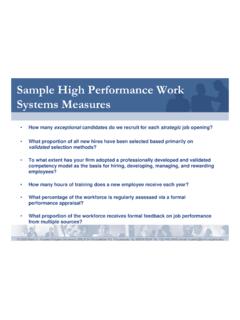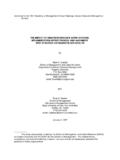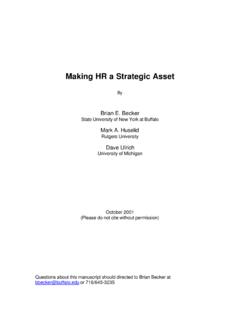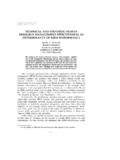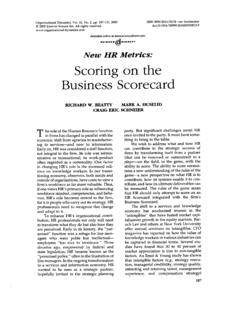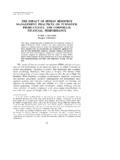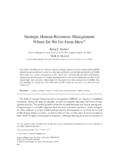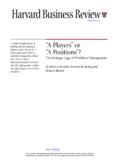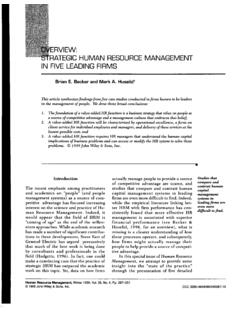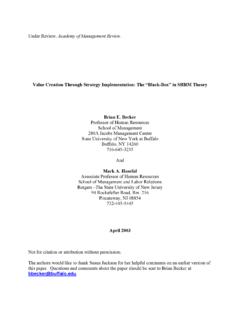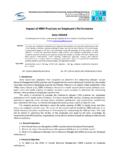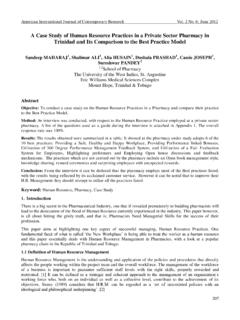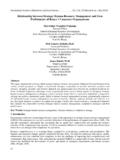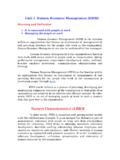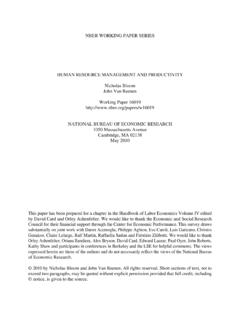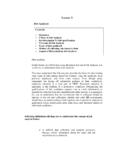Transcription of RESEARCH NOTES - Linking people, strategy, and …
1 RESEARCH NOTES Academy of Management Journal1996, Vol. 39, No. 4, 949 IMPACT OF HUMAN RESOURCE MANAGEMENTPRACTICES ON PERCEPTIONS OFORGANIZATIONAL PERFORMANCEJOHN T. DELANEYU niversity of IowaMARK A. HUSELIDR utgers UniversityIn 590 for-profit and nonprofit firms from the National OrganizationsSurvey, we found positive associations between human resource man-agement (HRM) practices , such as training and staffing selectivity, andperceptual firm performance measures.
2 Results also suggest method-ological issues for consideration in examinations of the relationshipbetween HRM systems and firm recent years, companies have been urged to adopt a variety ofperformance-enhancing or progressive human resource management (HRM) practices to improve their competitiveness in the global marketplace ( of Labor, 1993). Such recommendations are unsurprising giventhat professionals and academics have long asserted that the way in whichan organization manages people can influence its performance .
3 Spurred byPeters and Waterman s (1982) description and assessment of excellent organizations, the past decade has produced many testimonials to the valueof progressive hrm practices and systems of such practices . In particular,employee participation and empowerment and job redesign, including team-based production systems, extensive employee training, and performance -contingent incentive compensation, are widely believed to improve the per-formance of organizations (Pfeffer, 1994).
4 Moreover, a developing body ofresearch has reported positive associations between firm-level measures ofHRM systems and organizational performance (Arthur, 1994; Cutcher--Gershenfeld, 1991; Delaney, forthcoming; Huselid, 1995; Huselid & Becker,1994; Ichniowski, Shaw, & Prennushi, 1994; MacDuffie, 1995). Substantialuncertainty remains, however, as to how hrm practices affect organizationalThe data used in this study were provided by the Inter-university Consortium for Politicaland Social RESEARCH (ICPSR), which is not responsible for any of our conclusions.
5 We aregrateful to Barry Gerhart, Susan Schwochau, and two anonymous referees for helpful commentsand of Management JournalAugustoutcomes, whether some practices have stronger effects than others, andwhether Complementarities or synergies among such practices can furtherenhance organizational performance (Baird & Meshoulam, 1988; Jackson &Schuler, 1995; Lado & Wilson, 1994; Milgrom & Roberts, 1995; Wright &McMahan, 1992).This study extends empirical RESEARCH on the firm-level impact of pro-gressive hrm practices in three ways.
6 First, we draw on a unique nationalprobability sample of for-profit and nonprofit organizations to evaluate theassociation between a variety of progressive hrm practices and perceptualmeasures of organizational performance . Second, we conduct some rudimen-tary empirical tests of the effect of Complementarities among HRM practiceson firm-level outcomes. Finally, we identify some important methodologicalissues that merit consideration as scholars and practitioners seek to betterunderstand the relationship between hrm practices and firm AND HYPOTHESESR esearch focusing on the firm-level impact of hrm practices has becomepopular in recent years (for reviews, see Appelbaum and Batt [1994]; Berg,Appelbaum, Bailey, and Kalleberg [1994]; Huselid [1995]; Ichniowski et al.)
7 [1994]; and Wagner [1994]). The literature includes studies that focus on theperformance effects of specific hrm practices , such as training (Bartel, 1994;Knoke & Kalleberg, 1994) and information sharing (Kleiner& Bouillon, 1988;Morishima, 1991), and RESEARCH that examines the influence of systems ofsuch practices on organizational outcomes (Huselid, 1995; Huselid & Becker,1994; Ichniowski et al., 1994; MacDuffie, 1995). Although many studies havereported a positive association between various hrm practices and objectiveand perceptual measures of firm performance , some authors (Levine & Tyson,1990; Wagner, 1994) have expressed concern that results may be biasedbecause of methodological problems.
8 In addition, the absence of a widelyaccepted measure of the progressive or high performance HRM practicesconstruct makes it difficult to compare findings across studies (for examplesof different approaches, see Appelbaum and Batt [1994]; Cutcher-Gershenfeld[1991]; Huselid [1995]; Ichniowski et al. [1994]; and MacDuffie [1995]). None-theless, the literature can be generally categorized as optimistic concerningthe potential for progressive hrm practices to enhance the performanceof employees and organizations.
9 The optimism has stimulated additionaltheoretical and empirical from different disciplines have suggested various conceptualframeworks as explanations for the links between progressive HRM practicesand firm-level outcomes. Jackson and Schuler (1995) reviewed this literatureand reported that approaches as divergent as general systems theory (vonBertalanffy, 1950), role behavior theory (Katz & Kahn, 1978), institutionaltheory (Meyer & Rowan, 1977), resource dependence theory (Pfeffer& Cohen,1984), human capital theory (Becker, 1964), transaction cost economics (Wil-liamson, 1979), agency theory (Jensen & Meckling, 1976), and the resource-based theory of the firm (Barney, 1991)
10 Have been used to study the potential1996 Delaney and Huselid951role of human resources (and thus hrm practices ) in the determination offirm performance . Although a review of each of these frameworks is beyondthe scope of this study, the prior conceptual work generally converges onthe importance of hrm practices in the determination of both employee andfirm-level outcomes. Conceptually, such practices can be classified in termsof their impact on employees skills and ability, motivation, and the waythat work is structured (Arthur, 1994; Bailey, 1993; Cutcher-Gershenfeld,1991; Huselid, 1995; Ichniowski et al.)
